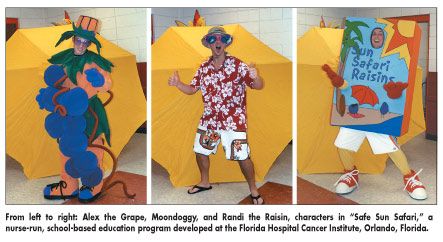Sun safety program for younger kids gets shining results
A nurse-run program for Florida school children has been tremendously successful in teaching them how to protect their skin when in the sun
LAS VEGASA nurse-run program for Florida school children has been tremendously successful in teaching them how to protect their skin when in the sun, Victoria Chambers, RN, OCN, reported at the 32nd Annual Congress of the Oncology Nursing Society (abstract 2006).
"We wanted to do a community service project, and decided to take on young childrenelementary school age and younger," Ms. Chambers told Oncology NEWS International in an interview.
Using funds procured from a foundation, she and her colleagues at the Florida Hospital Cancer Institute in Orlando developed a school-based education programtitled "Safe Sun Safari"to teach and reinforce practices that reduce the risk of skin cancer by decreasing sun exposure. Their aim was to reach 100 children every month.
The central component of the program is an interactive, 15-minute play that is put on at elementary schools, after-school program settings, and daycare centers.
The play includes dialog, songs, and a game that incorporate sun-safe messages, such as the "slip, slop, slap" message of the American Cancer Society (slip on a shirt, slop on sunscreen, slap on a hat).
The cast has four charismatic characters who wear bright, colorful costumes: the Sun, who mainly shines on her fellow characters; Alex the Grape, who likes to sunbathe without sunscreen; Moondoggy, the story teller, a California-cool dude who always wears sunscreen, sunglasses, and a hat; and Randi the Raisin, who has been burned by the sun and therefore urges Alex the Grape to use sun safe practices (see photographs).
"The children are just in awe of these characters, even so much so that at the end of the show, they want their autographs," Ms. Chambers commented.
The play is presented with a playbill and a package for children to take home with them. "Inside the package, there is a safari hat with "Safe Sun Safari" on it, a little sunscreen sample, a container of lip balm, a water bottle, and an activity booklet," Ms. Chambers said. "The kids are told to take home the booklet and read it with their mom and dad or guardian, so that the parents are learning as well as the kids."
In addition, children are given a test before and after the play to assess their knowledge of skin protection, both also to be done at home with their parents. "So far, we have had at least a 75% improvement rate from the pretest to the post-test, which is significant really," she said.
After turning in the post-test, the children are given a certificate that bears the Safe Sun Pledge stating that they know they need to protect themselves from the dangers of UV rays, that they will share this information with their friends and family, and that they will try to be safe in the sun.

The program, which has been up and running for a year, has been presented to about 15 groups of children. Based on the program's success in Florida, Ms. Chambers said that her team may try to take it nationally.
"We are doing some things with Disney World in Orlando, and we are looking also at maybe creating a patch for the Girl Scouts for sun safety," she said.
Ms. Chambers noted that the same concept could easily be applied in other community settings. "You certainly don't have to be this elaborate," she commented. "You can do it at a very low cost and yet get the message across in an entertaining way, which is the key for kids. It has to be fun or they are not buying it." She added that it is also important to gear this particular type of program to younger children to ensure buy-in, because older children find it silly.
"I am very proud to be part of this. We worked very hard to get this off the groundit didn't just fall into our laps. We had to get grants and we had to budget, find the characters, and rehearse, so it really was a lot of groundwork," Ms. Chambers concluded. "But now that it's going, it's just great, great fun."